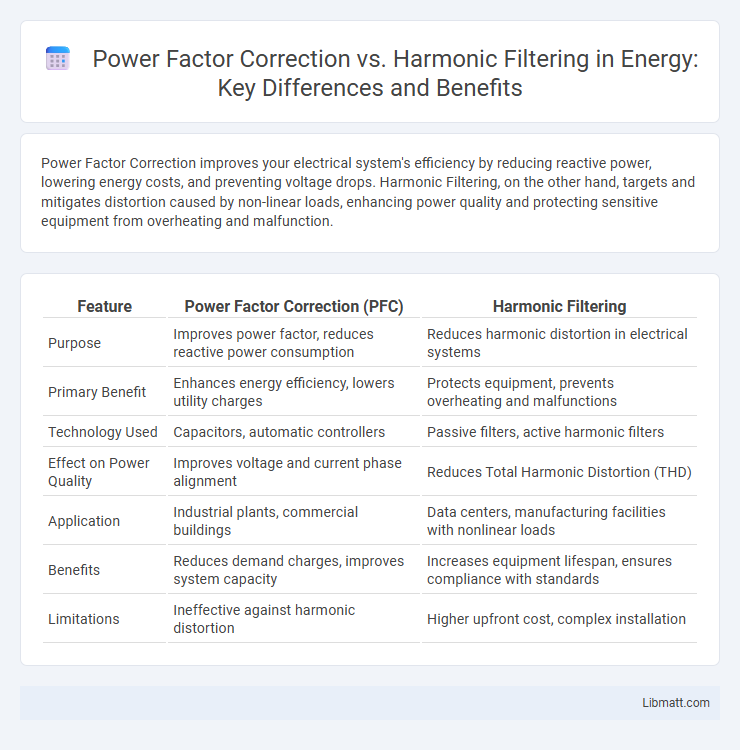Power Factor Correction improves your electrical system's efficiency by reducing reactive power, lowering energy costs, and preventing voltage drops. Harmonic Filtering, on the other hand, targets and mitigates distortion caused by non-linear loads, enhancing power quality and protecting sensitive equipment from overheating and malfunction.
Table of Comparison
| Feature | Power Factor Correction (PFC) | Harmonic Filtering |
|---|---|---|
| Purpose | Improves power factor, reduces reactive power consumption | Reduces harmonic distortion in electrical systems |
| Primary Benefit | Enhances energy efficiency, lowers utility charges | Protects equipment, prevents overheating and malfunctions |
| Technology Used | Capacitors, automatic controllers | Passive filters, active harmonic filters |
| Effect on Power Quality | Improves voltage and current phase alignment | Reduces Total Harmonic Distortion (THD) |
| Application | Industrial plants, commercial buildings | Data centers, manufacturing facilities with nonlinear loads |
| Benefits | Reduces demand charges, improves system capacity | Increases equipment lifespan, ensures compliance with standards |
| Limitations | Ineffective against harmonic distortion | Higher upfront cost, complex installation |
Introduction to Power Factor Correction and Harmonic Filtering
Power Factor Correction (PFC) improves electrical system efficiency by reducing reactive power and optimizing voltage usage, directly lowering energy costs and avoiding utility penalties. Harmonic Filtering targets distortion in current and voltage waveforms caused by non-linear loads, protecting sensitive equipment and enhancing power quality. Understanding your system's needs helps determine whether Power Factor Correction or Harmonic Filtering is the best solution for improving electrical performance.
Understanding Power Factor and Its Importance
Power factor correction improves your electrical system's efficiency by minimizing reactive power and aligning voltage and current waveforms, which reduces energy losses and lowers utility costs. Harmonic filtering targets unwanted harmonic distortions caused by non-linear loads, protecting equipment and ensuring compliance with power quality standards. Understanding power factor is crucial because a low power factor increases demand charges and strains infrastructure, while effective correction and filtering enhance overall system reliability and performance.
What Are Harmonics in Electrical Systems?
Harmonics in electrical systems are voltage or current waveforms that deviate from the fundamental frequency, typically caused by nonlinear loads such as variable speed drives and electronic devices. They distort the power quality, leading to overheating, equipment malfunction, and increased energy losses. Your electrical infrastructure requires harmonic filtering to mitigate these distortions, while power factor correction primarily improves efficiency by reducing reactive power.
Causes and Consequences of Poor Power Factor
Poor power factor results from inductive loads such as motors and transformers drawing more reactive power, leading to increased current flow and higher energy losses in electrical systems. This inefficiency causes voltage drops, overheating of equipment, and penalties from utility companies due to wasted energy. Your power factor correction improves system efficiency by reducing reactive power, while harmonic filtering targets distortion from non-linear loads, both essential for optimizing energy use and protecting infrastructure.
How Harmonics Affect Electrical Equipment
Harmonics distort the sinusoidal waveform of electrical power, causing overheating and premature aging in motors, transformers, and capacitors. These distortions increase electrical losses and reduce the efficiency of power systems, leading to higher operational costs. Implementing harmonic filtering minimizes these adverse effects by reducing harmonic currents and ensuring stable and reliable equipment performance.
Methods of Power Factor Correction
Power factor correction methods primarily include passive correction using capacitor banks, active power factor correction utilizing power electronics such as active front-end converters, and hybrid systems combining both approaches. Capacitor banks provide reactive power support to offset inductive loads, improving overall power factor, while active correction techniques dynamically adjust the power factor through real-time control, reducing harmonic distortion. Selecting appropriate methods depends on system characteristics, load types, and the need to maintain compliance with power quality standards such as IEEE 519.
Techniques for Harmonic Filtering
Harmonic filtering techniques include passive filters, active filters, and hybrid filters, each targeting specific harmonic orders to improve power quality. Passive filters use inductors, capacitors, and resistors to attenuate harmonics passively, ideal for fixed-frequency harmonics. Active filters utilize power electronics to dynamically compensate for a wide range of harmonic frequencies, adapting in real-time to changing load conditions for your electrical system.
Comparative Benefits: Power Factor Correction vs Harmonic Filtering
Power factor correction improves energy efficiency by reducing reactive power and lowering electricity bills, while harmonic filtering focuses on minimizing electrical distortions that can damage equipment and reduce system reliability. You benefit from enhanced system performance and extended lifespan of electrical components when combining both solutions, addressing both power quality and energy savings. Optimizing your electrical system with power factor correction and harmonic filtering leads to reduced utility charges and improved operational stability.
Selecting the Right Solution for Your Facility
Power factor correction improves energy efficiency by reducing reactive power, while harmonic filtering minimizes distortion caused by non-linear loads, ensuring equipment longevity and compliance with standards. Selecting the right solution depends on analyzing your facility's specific electrical load characteristics, power quality issues, and budget constraints. Combining both technologies often provides optimal performance by enhancing power quality and reducing operational costs.
Future Trends in Power Quality Improvement
Future trends in power quality improvement emphasize the integration of advanced Power Factor Correction (PFC) techniques with dynamic Harmonic Filtering to enhance grid stability and energy efficiency. Emerging technologies like active filters combined with machine learning algorithms optimize real-time compensation for reactive power and harmonic distortion, reducing losses and equipment wear. Your electrical systems will benefit from predictive maintenance and adaptive control, ensuring compliance with increasingly stringent regulatory standards and supporting the growth of renewable energy sources.
Power Factor Correction vs Harmonic Filtering Infographic

 libmatt.com
libmatt.com